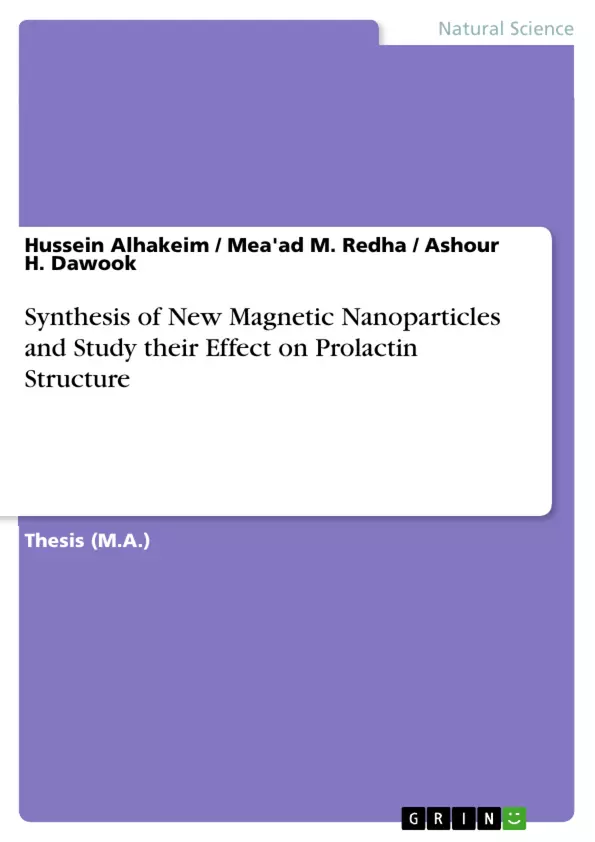The National Nanotechnology Initiative defines nanotechnology as the manipulation of matter to at least one dimension sized from 1 to 100 nm. This definition shifted from a particular technological goal to a research category inclusive of all types of research and technologies that deal with the special properties of matter that occur below the given size threshold. These unique effects often provide nanoscale materials the desired chemical, physical, and biological properties that differ from those of their larger or bulk counterparts .
Inhaltsverzeichnis (Table of Contents)
- Chapter One
- Introduction
- Nanotechnology
- Nanoparticle
- Properties
- Shape
- Physical properties
- Chemical Properties
- Optical properties
- Ferromagnetic Properties
- Surface coating for biological applications
- Applications of NPs in biology and medicine
- Magnetic nanoparticles
- Definition
- Properties
- Types of magnetic nanoparticles
- Oxides: ferritel
- Metallic
- Metallic with a shell
- Preparation Methods of Magnetic
- Applications Of Magnetic NPS
- Preperation of the modified magnetic NPs
- Identification of NP
- Protein-NPs Interaction
- Prolactin (PRL)
- Folic acid
- Palmitic acid
- Adsorption of Proteins
- Aim of the study
- Introduction
- Chapter two
- Method And Materials
- Identification of the prepared NPs
- Estimation of Prolactine Concentration by ELISA
- Estimation of Equilibrium Time of Adsorption
- Adsorption Isotherms
- Thermodynamicsof the Adsorption of PRL on MNPS
- Desorption process
- Chapter three
- Result & discussion
- Prolactin-MNP compounds Interaction
- Application of protein-NPs conjugates.
- Conclusions
- Recommendations
- References
Zielsetzung und Themenschwerpunkte (Objectives and Key Themes)
This study aims to synthesize new magnetic nanoparticles and investigate their effects on the structure of prolactin. The primary objective is to understand the interactions between magnetic nanoparticles and the protein prolactin, specifically focusing on the adsorption process and its thermodynamic parameters. The study also aims to explore the potential applications of these nanoparticles in biological systems. Key themes explored in the text include:- Synthesis and Characterization of Magnetic Nanoparticles
- Interaction of Nanoparticles with Prolactin
- Adsorption Isotherms and Thermodynamics of Adsorption
- Potential Applications of Magnetic Nanoparticles in Biological Systems
- Impact of Nanoparticles on Prolactin Structure
Zusammenfassung der Kapitel (Chapter Summaries)
Chapter One: Introduction
Chapter one provides a comprehensive overview of nanotechnology, nanoparticles, and their properties. It delves into the diverse applications of nanoparticles in various fields, particularly in biology and medicine. The chapter focuses on magnetic nanoparticles, their characteristics, and their preparation methods. It further explores the wide range of applications of magnetic nanoparticles, encompassing medical diagnostics, treatments, waste water treatment, and other areas. The chapter concludes by introducing the concept of protein-nanoparticle interactions and discussing the adsorption of proteins on nanoparticles. The chapter also provides details on prolactin, folic acid, and palmitic acid, which are crucial to the study's investigation.Chapter Two: Method and Materials
This chapter details the methodology and materials employed in the study. It describes the synthesis of magnetic nanoparticles and their modifications with folic acid and palmitic acid. The chapter outlines the techniques used for identifying and characterizing the synthesized nanoparticles, including Transmission Electron Microscopy (TEM), Scanning Electron Microscopy (SEM), Fourier Transform Infrared Spectroscopy (FTIR), Dynamic Light Scattering (DLS), and Thermogravimetric Analysis (TGA). It also explains the procedures used for estimating prolactin concentration and investigating the adsorption process, including the determination of equilibrium time, adsorption isotherms, and thermodynamic parameters. The chapter concludes with a discussion of the desorption process.Chapter Three: Results and Discussion
This chapter presents the findings of the study and discusses their implications. It starts with a comprehensive characterization of the synthesized magnetic nanoparticles, encompassing their properties and modifications. The chapter then focuses on the interaction between prolactin and the magnetic nanoparticles, examining the equilibrium time, the properties of the nanoparticles after interaction with prolactin, and the adsorption process. The chapter evaluates the applicability of Langmuir and Freundlisch adsorption isotherms to the system, analyzes the thermodynamics of the adsorption process, and explores the desorption process. The chapter concludes with a discussion of the potential applications of protein-nanoparticle conjugates.Schlüsselwörter (Keywords)
The study focuses on the synthesis, characterization, and application of magnetic nanoparticles. Key keywords include: magnetic nanoparticles, prolactin, adsorption, thermodynamics, Langmuir isotherm, Freundlich isotherm, TEM, SEM, FTIR, DLS, TGA, biological applications.
Ende der Leseprobe aus 100 Seiten
- nach oben
- Arbeit zitieren
- Hussein Alhakeim (Autor:in), Mea'ad M. Redha (Autor:in), Ashour H. Dawook (Autor:in), 2014, Synthesis of New Magnetic Nanoparticles and Study their Effect on Prolactin Structure, München, GRIN Verlag, https://www.hausarbeiten.de/document/283116
Blick ins Buch


